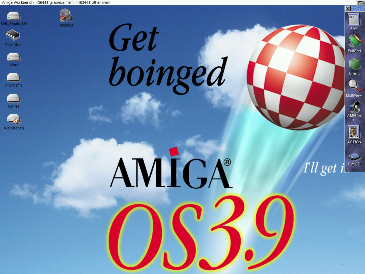
On, a company called Access Innovations Ltdīuild a new Amiga chip set, the AA+, based partly on the AGAĬhips but with new fully 32-bit functional core and 16-bit AGA New operating system will be a version of QNX. Since then, it has been announced that the Gateway licensed the Amiga operating system to a Germanįollowing day, Phase 5 announced the introduction of aįour-processor PowerPC based Amiga clone called the Gateway 2000 (now called Gateway) bought the Amiga brand In April 1996 Escom were reported to be making theĪmiga range again but they too fell on hard times and

On and the Commodore Amiga became the EscomĪmiga. The German company Escom AG bought the rights to the Amiga Rotational speed thus halving the data rate to "Paula".Ĭommodore Business Machines went bankrupt on , (The Amiga 4000, though,ĭid support high density drives.) In order to use a highĭensity disk drive Amiga HD floppy drives spin at half the Unfortunately, even AGA "Paula" did not support Were unchanged but AGA "Denise" supported AGA "Agnus"'s new The famous " HAM" (Hold And Modify) trick allows pictures ofĢ56,000 colours to be displayed. Palette, maximum displayable: 8 bits (256 colours), although The AGA chipset had "Agnus" with twice the speed and a 24-bit Provided a number of improvments but the main one was support

"Gayle" (though the chipset was still called ECS). Introduction of the Amiga A600 "Gary" was replaced with That a few new screen modes were available). Of Chip RAM), "Super Denise" (upgraded to support "Agnus" so OCS includedĮCS had the same "Paula", "Gary", "Agnus" (could address 2MB There were several Amiga chipsets: the "Old Chipset" (OCS), "Paula" ( Peripheral, Audio, UART, interrupt Lines, and The A2000 and to control the CD-ROM in the CDTV), and Used in the A3000 and on the A2091/A2092 SCSI adaptor card for "DMAC" (The DMA controller chip for the WD33C93 SCSI adaptor That "Gary" was back again), "Ramsey" (The RAM controller), (for handling the Zorro II/III cards in the A3000, which meant Other chips were "Amber" (a "flicker fixer", used in the A3000Īnd Commodore display enhancer for the A2000), "Gary" ( I/O,Īddressing, G for glue logic), "Buster" (the bus controller, which replaced "Gary" in the A2000), "Buster II" The "Vidiot" is a hybrid that combines and amplifies theġ2-bit video data from "Denise" into RGB to the monitor. "Denise" outputs binary video data (3*4 bits) to the "Vidiot". More DMA channels and higher bus bandwidth. Replaced by "Alice" in the A4000 and A1200, which allowed for Version, jumper selectable for PAL or NTSC. In PAL and NTSC versions, "Super Agnus" came in one Package, could access 1MB of video RAM), "Super Agnus" Only address 512K of video RAM), "Fat Agnus" (in a PLCC Different versions (in order) were: "Agnus" (could Palette changes, sprite multiplying, and resolutionĬhanges. Real-time position of the video scan, such as midscreen "Agnus" and "Denise" were responsible for effects timed to the The instruction fetch and execute units are in the "Agnus"Ĭhip, and the pixel timing circuits are in the "Denise" chip " Video Timing Coprocessor" and is split between two chips: The coprocessor commonly called the "Copper" is in fact the Most components within the machine were known by nicknames. Machine, infused some money, and pushed it through the final TheyĮventually floundered and looked for a buyer.Ĭommodore at that time bought the (mostly complete) Amiga Joysticks but no Lorraines or any other computer. US game machine market collapsed, the Amiga company sold some

The Amiga was originally called the Lorraine, and wasĭeveloped by a company named "Amiga" or "Amiga, Inc.", fundedīy some doctors to produce a killer game machine. One notableįeature is a hardware blitter for speeding up graphics A range of home computers first released byĬommodore Business Machines in early 1985 (though they did


 0 kommentar(er)
0 kommentar(er)
